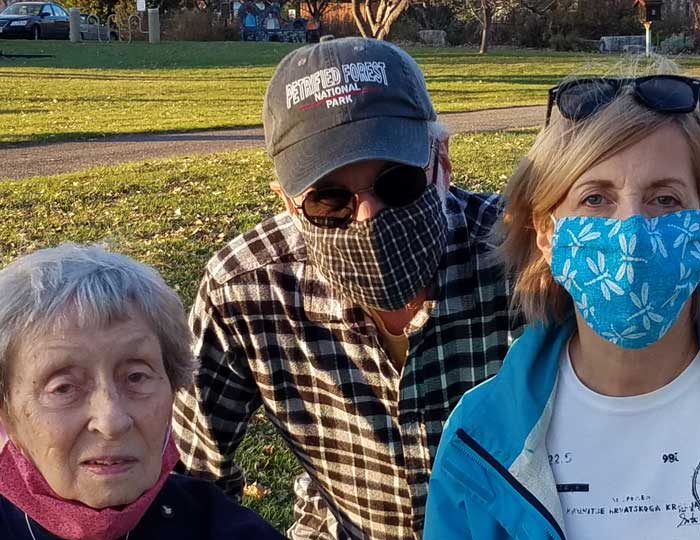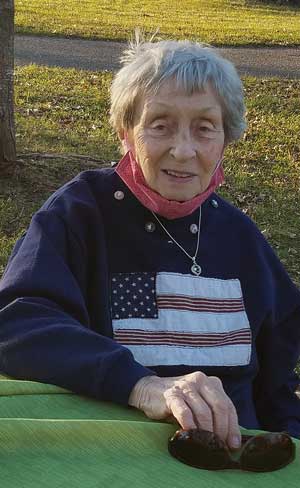By Merry Roth, Guest Contributor

Before the arrival of COVID-19, my 89-year-old mother led a fairly active and varied life in her assisted living apartment building. Although she needed a walker to get around, she hosted regular Bingo games, took the transport for grocery shopping, attended church services and visited the library across the street for the latest lectures. Every Friday I would join her at noon for lunch downstairs, and then we’d take a drive to find some treasure at a local thrift store.
All of that changed in March when reports indicated that seniors in congregate living situations were at the greatest risk if exposed to the coronavirus. Following CDC guidelines, her facility imposed strict new rules, sequestering residents in their apartments, curtailing social activities and eliminating outside physical contact from both family and fellow residents. In essence, that meant solitary confinement.
The onset
Mom has always relied upon me to keep her independent and on track. I manage her finances and medications. And do all those small things—like replacing light bulbs and batteries, removing tripping hazards and expired food, changing the clocks for daylight savings, finding the lost hearing aid—all to preserve her dignity, safety and connection to the world. Now, with the new rules in place, I wasn’t allowed in the building to do those things, and her world began to unravel.
“As well-intentioned as the facility’s mandates were, they soon had a devastating effect on my mother’s wellness.”

As well-intentioned as the facility’s mandates were, they soon had a devastating effect on my mother’s wellness. Within a few months, Mom’s mental condition deteriorated. She lost interest in eating and any regular sleep schedule and began having frightening hallucinations. Then the bouts of paranoia began, so strong that she stopped answering the phone or trusting anyone. Staff would call me at all hours to report that she was either having another crying episode or trying to leave the building alone at night (often without keys to get back in). She was clearly having some sort of breakdown, and the staff was not equipped to handle it.
Because of COVID-19, her usual clinic had virtually shut down. We were in dire need of some medical guidance, but her doctor was only available two days, every other week—and this wasn’t our lucky week. From various calls to nurses and health hotlines, I gathered enough information to act on my own. First, we tested for dehydration and a urinary tract infection and then, brain abnormalities with a CT scan. All results came back normal, but it was clear she needed a higher level of care. After querying her general practitioner, all he offered was, “She probably has dementia.” No course of action and no referrals to other facilities were given.
Some respite becomes available
Just by chance, I found out that Medicare (considering the impact of the coronavirus) had waived the mandatory three-day hospital stay before a rehabilitation facility would be covered. A godsend! We jumped at the chance and moved Mom to a local skilled nursing home with a special focus on elder care. However, we soon discovered that the doctor in residence was her own general practitioner, and there was no other psychologist or geriatrician on staff, as their website led us to believe.
The hunt was on to find a responsive doctor to unravel the extent of Mom’s distress. Her Medicare supplemental insurance company surprisingly had NO listing for psychiatrists or geriatricians. How could that be? A Medicare plan should have extensive resources for older adults to address mental healthcare needs that arise with aging. Thankfully, after a number of searches online, the Alzheimer’s Association came through for us. We found a seasoned geriatric psychiatrist who was willing to meet us—in-person—to help manage Mom’s debilitating condition.
Then another bump in the road. After six weeks in the rehab clinic, they notified us that Medicare coverage would be ending. Mom would need to be moved to their long-term care wing—at the unaffordable price of $9,000/month (out-of-pocket). Fresh out of viable options, I invited her back to my home until the virus took a downturn. We proceeded to make our house more accessible by moving furniture and taking up rugs, attaching multiple grab bars and installing a raised toilet seat. For a couple of weeks we were together 24/7, chatting, doing crafts, sharing meals and enjoying the summer days on the patio. But she grew tired of being a live-in guest (and a burden, she decided) and asked to go back to her assisted living apartment. Some of her anxiety had subsided with her new prescriptions, but she would be venturing back into isolation at her apartment building where her problems began. This was worrisome.
Returning home
In returning, we were buoyed by the changes that had taken place. Although there had been a few cases of the virus reported in the building, the staff had gained experience managing congregate living in a healthier way. More attention was now given to the residents’ needs for socialization in a safe way, and the staff actively consulted family members about challenges with their loved ones. Virtual chats hosted by staff help bridge the separation gap with our family and assisted our geriatric psychiatrist in meeting with Mom and me online to tweak her meds, if needed. We also opted for additional services to keep her on track: staff-monitored pill-dispensing and a silent door alarm that would send an alert if she exited her apartment after dark. Although Mom’s dementia will most likely progress, we have found a balance that currently works for everyone involved. Here’s hoping we can continue to do so in the years to come.
A journey unfinished
Managing my mother’s onset of dementia during a pandemic has been one of the most frustrating and challenging experiences of my life. Navigating our complicated and disjointed healthcare system was a real eye-opener and made me realize how we as a society fall short in addressing the needs of older folks in crisis. Mom was lucky to have an advocate; not everyone does.
With 10,000 Americans turning 65 every day, why aren’t we better at managing health issues that can emerge with aging and creating a smoother path for continuity of care? I was disappointed at the reluctance of healthcare professionals to make recommendations for treating my mom’s condition and help direct us to other specialists and institutions that might help. Are the elderly considered to be more trouble than they are worth? Was the pandemic partially to blame?
In closing, I’d like to thank all the doctors, nurses and aides that did go above and beyond for my mom and me in the past several months, and who continue to provide support for her journey through the challenges of later life.
ng. Although she needed a walker to get around, she hosted regular Bingo games, took the transport for grocery shopping, attended church services and visited the library across the street. Before the arrival of COVID-19, my 89-year-old mother led a fairly active and varied life in her assisted living apartment building. Although she needed a walker to get around, she hosted regular Bingo games, took the transport for grocery shopping, attended church services and visited the library across the street



